VERS UNE MEMOIRE QUANTIQUE AVEC DES IONS PIEGES
VERS UNE MEMOIRE QUANTIQUE AVEC DES IONS PIEGES
VERS UNE MEMOIRE QUANTIQUE AVEC DES IONS PIEGES
You also want an ePaper? Increase the reach of your titles
YUMPU automatically turns print PDFs into web optimized ePapers that Google loves.
tel-00430795, version 1 - 9 Nov 2009<br />
5.1. REPRODUCTION DE L’ARTICLE 119<br />
2 S. Removille et al.<br />
of its two-photon character, TPPI has the potential advantage<br />
to define a well-localized spatial region for the<br />
ion production associated with the waist of the ionising<br />
beam[16]. This facilitates the ion creation at the center<br />
of the trap with an initially low potential energy. In<br />
the particular case of our trap (atomic beam spread of<br />
8 mm on the trap axis), we compared the theoretical<br />
performances of TPPI and TSPI (assuming equivalent<br />
ionisation rates) and we found an initial temperature<br />
six times lower for TPPI. More generally, for perfectly<br />
Fig. 1 Relevant energy levels of neutral Strontium involved<br />
in: a) two-step photoionisation TSPI; b) two-photon photoionisation<br />
TPPI discussed in this paper. c) Relevant energy<br />
levels of Sr + ion involved in Doppler cooling.<br />
collimated atomic beams, the expected initial temperature<br />
is at least two times lower for TPPI than for TSPI.<br />
Finally, from a practical point of view, the TPPI setup<br />
presents the advantage of flexibility because the same<br />
frequency-doubled tunable ultrafast source can be used<br />
for the ionisation of different atomic species.<br />
2 Experimental setup<br />
The level structure of the Sr atom is similar to that of<br />
most atoms with two electrons in the outer shell (the<br />
relevant levels are represented in Figure 1a). The 1 P1<br />
intermediate level has been used to implement TSPI<br />
technique in Sr[7], following the example of Ca[5] and<br />
Yb[13]. In the particular case of the Sr atom, the presence<br />
of a (4d 2 +5p 2 ) 1 D2 autoionising state that lies above<br />
the ionisation threshold is very helpful to increase the<br />
photoionisation efficiency. The spectral characteristics of<br />
this state have been investigated earlier [18], in particular<br />
a cross section of 5500 Mb (1 Mb = 10 −22 m 2 )<br />
for the 1 P1 → (4d 2 + 5p 2 ) 1 D2 transition has been measured.<br />
Such an autoionising state can also be reached<br />
from the ground state by two-photon absorption: the<br />
(5s 2 ) 0 S0 → (4d 2 + 5p 2 ) 1 D2 two-photon transition has a<br />
linewidth of 0.7 nm FWHM (due to the short lifetime of<br />
the final state) and can be resonantly driven by two photons<br />
centered at 431 nm [19]. The strategy of the TPPI<br />
loading experiment described in this paper is based on<br />
this transition (Figure 1b).<br />
The neutral atomic beam is produced in an oven<br />
placed below the trap. The oven contains a dendritic<br />
piece of pure strontium (Aldrich) heated by a tungsten<br />
filament with a maximum operating current of 1.15 A,<br />
corresponding to a heating power of 1.3 W. Let us remark<br />
that the manipulation of pure Sr under argon atmosphere<br />
in a glove box did not produce visible oxidation<br />
of the sample. The temperature of the (bare) filament<br />
displays an approximate linear dependence on the<br />
current and we measured 110 ◦ C for 0.8 A and 170 ◦ C<br />
for 1.2 A. Such measurements have been carried out by<br />
recording the I-V characteristics and by taking into account<br />
the known dependence of the tungsten resistivity<br />
as function of the temperature. In these conditions we<br />
expect an Sr partial pressure near the filament roughly in<br />
the range 10 −13 – 10 −9 mbar[20]. An electron gun based<br />
on a thorium tungsten wire allows us to perform EB with<br />
a typical electron energy of 300 eV. The photoionising<br />
laser source is based on a homemade femtosecond Ti:Sa<br />
oscillator that produces 50 fs pulses of 1.5 nJ energy at<br />
862 nm with a repetition rate of 100 MHz. The pulses are<br />
frequency doubled in a 0.5 mm thick Beta Barium Borate<br />
(BBO) nonlinear crystal. The thickness of the crystal<br />
is such that group velocity mismatch negligibly affects<br />
pulse-duration. A pulse energy of more than 0.15 nJ is<br />
routinely obtained at 431 nm. The beam is directed into<br />
the vacuum chamber and focused at the center of the<br />
ion trap by a lens of focal distance 200 mm. The measured<br />
photoionising beam size at the waist is 20 ± 2 µm,<br />
corresponding to a peak intensity of 1 GW/cm 2 .<br />
Sr + ions are trapped in a standard linear Paul trap<br />
(see Figure 2) [21]. Four parallel rod electrodes (diameter<br />
6.35 mm, distance between the center of the trap and<br />
the electrode surfaces r0 = 3.2 mm) are used for the<br />
radio-frequency (rf) radial confinement. A 2.5 MHz rf<br />
potential with an amplitude Vrf in the range 50–500 V is<br />
applied to two of the diagonally opposed electrodes. The<br />
remaining two rods are normally grounded but can also<br />
be used to resonantly excite the ion motion in the trap<br />
(see below). The Sr + ion radial movement is defined by<br />
a typical secular frequency νR = 400 kHz for an applied<br />
voltage Vrf = 500 V. Two annular “end caps” separated


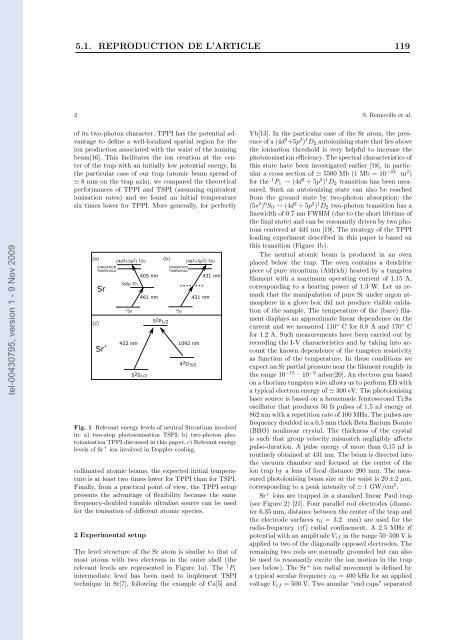

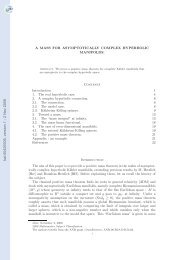
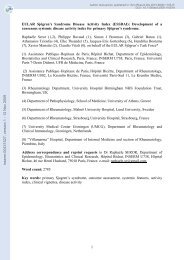
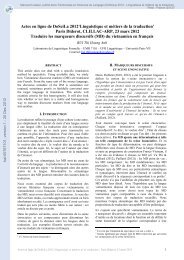
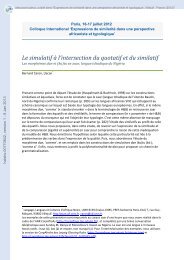
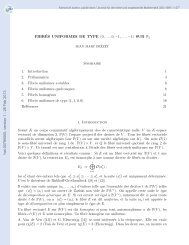
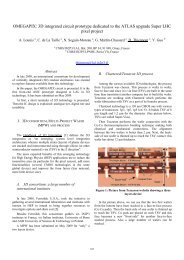
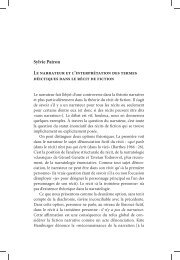
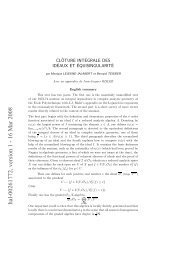
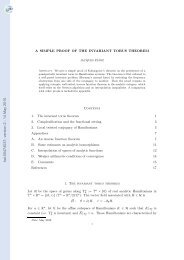

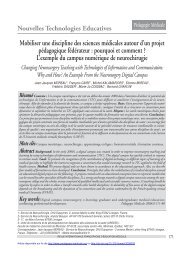

![[tel-00433556, v1] Relation entre Stress Oxydant et Homéostasie ...](https://img.yumpu.com/19233319/1/184x260/tel-00433556-v1-relation-entre-stress-oxydant-et-homeostasie-.jpg?quality=85)